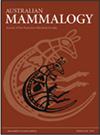考拉在公路上的死亡与昆士兰州中部的山顶唐斯高速公路的景观属性有关
IF 1.2
4区 生物学
Q3 ZOOLOGY
引用次数: 2
摘要
考拉(Phascolarctos cinereus)在穿越克拉克-康纳斯山脉的Peak Downs高速公路上经常被公路撞死。公路升级可以减少考拉与车辆碰撞的频率,同时保持考拉种群的联系。该项目旨在了解道路死亡的分布情况,为保护性基础设施投资提供信息。无尾熊道路死亡与:(1)河流及其相关冲积层有关,优势植被为桉叶和白桦;(2)与溪流或冲积带毗邻的疏林/林地支持疏林的山脊;(3)中下坡,以赤藓为主,被以赤藓±白桦为边缘的小溪所分割。在山脊上坡、峰顶或山丘上的褐皮树开阔林/林地中没有发生道路死亡,但在这一景观中有考拉发生。解释为什么考拉的道路死亡与景观特征有关需要调查。可能的原因是:(1)与水系、冲积层和土角林相关的景观要素支持相对较高的考拉数量,因此道路死亡风险相应较高;(2)这些景观要素中的工程道路建筑和道路边缘特征有利于考拉过马路。本文章由计算机程序翻译,如有差异,请以英文原文为准。
Koala road kills are linked to landscape attributes on Central Queensland’s Peak Downs Highway
Koala ( Phascolarctos cinereus ) road kills occur frequently along the Peak Downs highway through the Clarke-Connors ranges. Highway upgrades allowed mitigation of koala-vehicle collision frequency while maintaining koala population connectivity. This project aimed to understand road kill distribution to inform protective infrastructure investment. Koala road kills were associated with: (1) streams and associated alluvia where the dominant vegetation included Eucalyptus tereticornis and E. platyphylla ; (2) ridges supporting E. drepanophylla open forest/wood-land abutting streams or alluvia; and (3) mid-lower slopes, dominated by E. drepanophylla that were dissected by minor streams fringed by E. tereticornis ± E. platyphylla . Road kills did not occur in E. drepanophylla open forest/woodland on ridge upper slopes, crests or on hills, although koalas occur in this landscape. Explaining why koala road kills are linked to landscape features requires investigation. It is likely that: (1) landscape elements associated with drainage lines, alluvia and E. tereticornis support a relatively high koala abundance, and hence the road kill risk is corre-spondingly higher; and (2) the engineered road architecture and road verge characteristics in these landscape elements are conducive to koalas crossing the road.
求助全文
通过发布文献求助,成功后即可免费获取论文全文。
去求助
来源期刊

Australian Mammalogy
ZOOLOGY-
CiteScore
2.50
自引率
8.30%
发文量
26
期刊介绍:
Australian Mammalogy is a major journal for the publication of research in all branches of mammalogy. The journal’s emphasis is on studies relating to Australasian mammals, both native and introduced, and includes marine mammals in the Antarctic region. Subject areas include, but are not limited to: anatomy, behaviour, developmental biology, ecology, evolution, genetics, molecular biology, parasites and diseases of mammals, physiology, reproductive biology, systematics and taxonomy.
Australian Mammalogy is for professional mammalogists, research scientists, resource managers, consulting ecologists, students and amateurs interested in any aspects of the biology and management of mammals.
Australian Mammalogy began publication in 1972 and is published on behalf of the Australian Mammal Society.
 求助内容:
求助内容: 应助结果提醒方式:
应助结果提醒方式:


